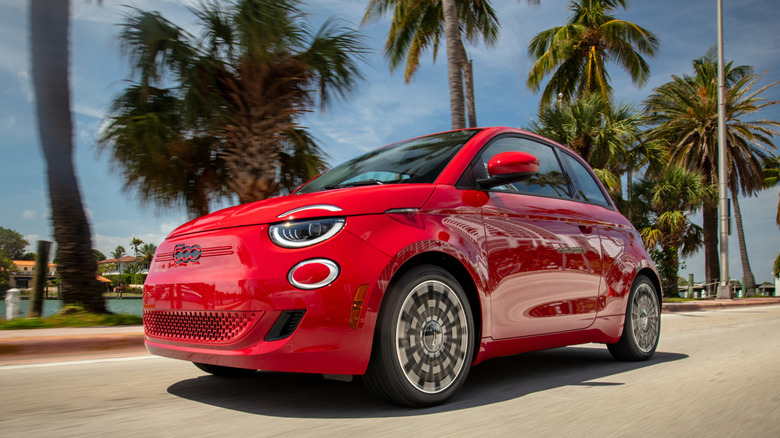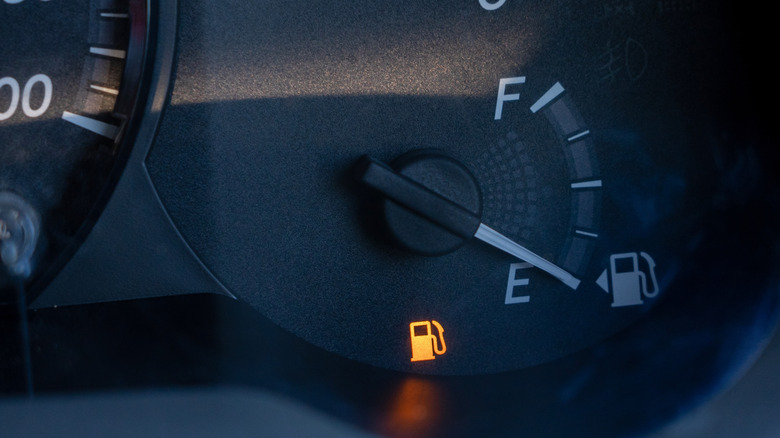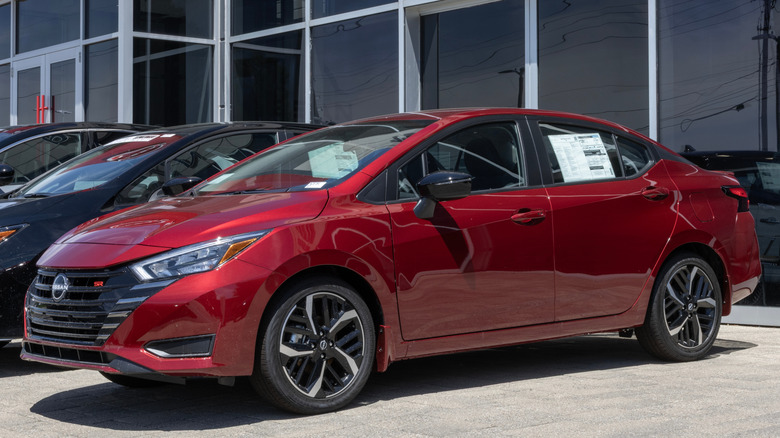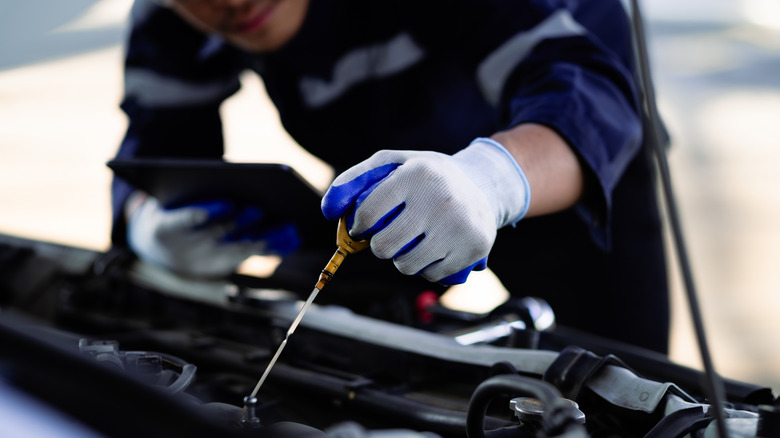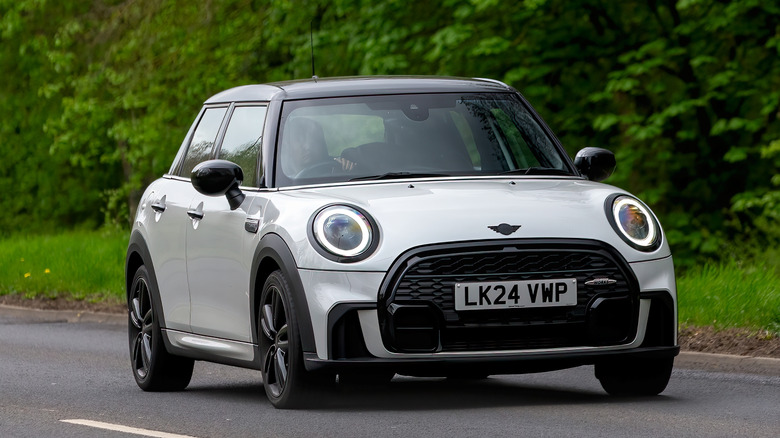5 Benefits Of Driving A Small Car You Might Not Have Considered
The best-selling vehicles in America are consistently SUVs and full-size pickup trucks, which sends a very clear message about American preferences. While there certainly are advantages to driving larger vehicles, such as impressive cargo capacities, commanding driving positions, and a feeling of safety, there are just as many benefits — if not more — to going in the other direction completely.
Small cars may not be as popular, but that doesn't make them a bad choice. Models such as the Fiat 500e, which we drove and reviewed last year, and the Mini Cooper have long captivated the interest of style-driven buyers, while cheaper offerings from home-grown brands such as Buick and Chevrolet cater to the budget-focused shoppers within America who prefer their cash in the bank and not in the driveway. As it happens, there are a whole host more reasons why driving a small car could be a great choice for you, with benefits such as better fuel economy, reduced running costs, and improved handling going hand-in-hand with driving a smaller car.
Fuel economy
One of the greatest benefits of driving a smaller car is the notable improvement you will see in fuel economy. Take some of the most popular SUVs in America, for example. The 2025 Toyota RAV4 manages to return a combined figure of 30 mpg, as does one of its key competitors, the Honda CR-V, which is rated to the same 30 mpg combined figure. The bigger you go, then generally the worse the fuel economy becomes, as seen with the Toyota Sequoia, which returns just 22 mpg from its hybridized powertrain.
At the other end of the scale, we find models like Toyota's cheapest SUV, the Corolla Cross, and compact Hyundai Kona. The former storms ahead with a combined rating of 32 mpg from the non-hybrid model, while the Hyundai sits just behind at 31 mpg combined. This isn't hugely more efficient than the RAV4 and HR-V, but those two are class-leaders in their own right, and actually quite small in the grand scheme of things, too. Compare these figures with the likes of what's possible from full-size models, such as the 19 mpg available from Ford's Expedition, and all of a sudden, the fuel savings on offer by choosing a smaller model become abundantly clear.
Parking
This might be one of the more obvious benefits of driving a small car, but one that will prove especially useful to anyone who lives or works within built-up urban areas where space is at a premium. While driving around in a luxuriously finished Escalade might be supremely comfortable, you'll wish you had a simple Chevy Trax when it comes to finding a parking space.
Just look at the size differences between these two models: A Trax measures up to 178.6 inches in length, whereas the gargantuan Escalade is 226.95 inches in comparison. With the latter measuring up almost 50 inches longer, it's understandably going to be an awful lot easier to squeeze the Trax into tight parking spaces. For anyone really looking to make the most of small car ownership, models like the Fiat 500e will prove to be especially useful for sliding into the tightest of parking spots. The dinky Fiat is just 143 inches in length and 66.3 inches wide, meaning parallel parking, even on the busiest of streets, should prove to be a breeze.
Purchase price
Cost-conscious shoppers should also try sizing down when it comes to buying their next car, as some of the cheapest cars on sale right now are compacts and sub-compacts. Be it the Mitsubishi Mirage or Nissan Versa, these diminutive cars are both available with MSRPs under $20,000. Nothing comes close to these in terms of sheer value, both of them sporting between 12 and 15 cubic feet of storage space in the trunk, and seating for five occupants.
That's enough room to constitute them as genuinely usable daily drivers for many of us. It's clear they won't suit large families, and they might be a bit basic inside, but if a cheap commuter is all you're in need of, then shopping small is the best way to get something suitable without breaking the bank. Most mid-size sedans, like the Honda Accord or Toyota Camry, will command around $10,000 more to even get hold of an entry-level model, which shows just how much could be saved by jumping behind the wheel of something a little smaller.
Maintenance costs
The savings don't end there either, as not only is buying a small car cheaper than buying a mid- or full-size model, but keeping one running and in good health is a lot easier and cheaper to do so also. This is why brands which produce a high amount of compact cars, such as Fiat, Toyota, and Mini, top the charts when it comes to requiring the least amount of maintenance.
There are good reasons as to why smaller cars are cheaper to maintain, and it's predominantly because they are lighter and simpler in construction. A light body means there is no need for a large and complex engine – usually just a small three- or four-cylinder engine will suffice – with a capacity somewhere between 1.0 and 2.0 liters. There is also no need to equip them with big, expensive brakes, or heavy-duty suspension setups, meaning perishable items such as brake pads and suspension bushes are usually cheap and cheerful to replace when required. They shouldn't need to be replaced all that often either, as smaller cars get through items like brake pads slower than large and heavy vehicles.
Handling and maneuverability
Finally, another reason for driving a small car that you might not have considered is that they can prove to be genuinely fun and exciting to drive. While we would never argue that a Mitsubishi Mirage is an Exige in disguise, small cars do tend to follow Lotus founder Colin Chapman's approach to "simplify, then add lightness". Low curb weights and a wheel in each corner is very typical of the smallest cars on sale right now. That approach is very similar to the one taken by the classic Mini, a model praised for its go-kart-like handling, and one which went on to enjoy much success in the world of both on- and off-road motorsport.
So, while that 1.0-liter sub-compact hatchback might not be too quick firing off at the lights, it just might be an absolute joy to zip around tight city streets in, or even down your favorite twisting road when taking the long way back from work.
